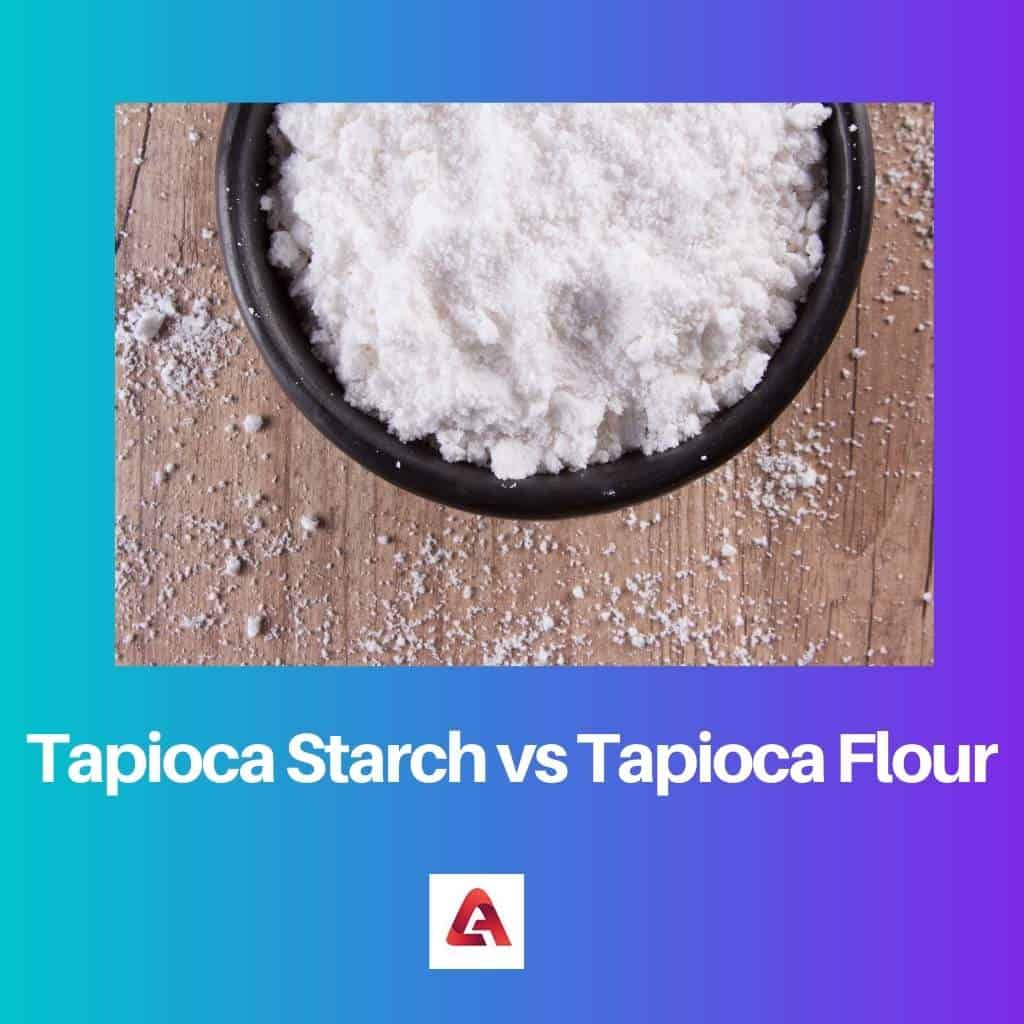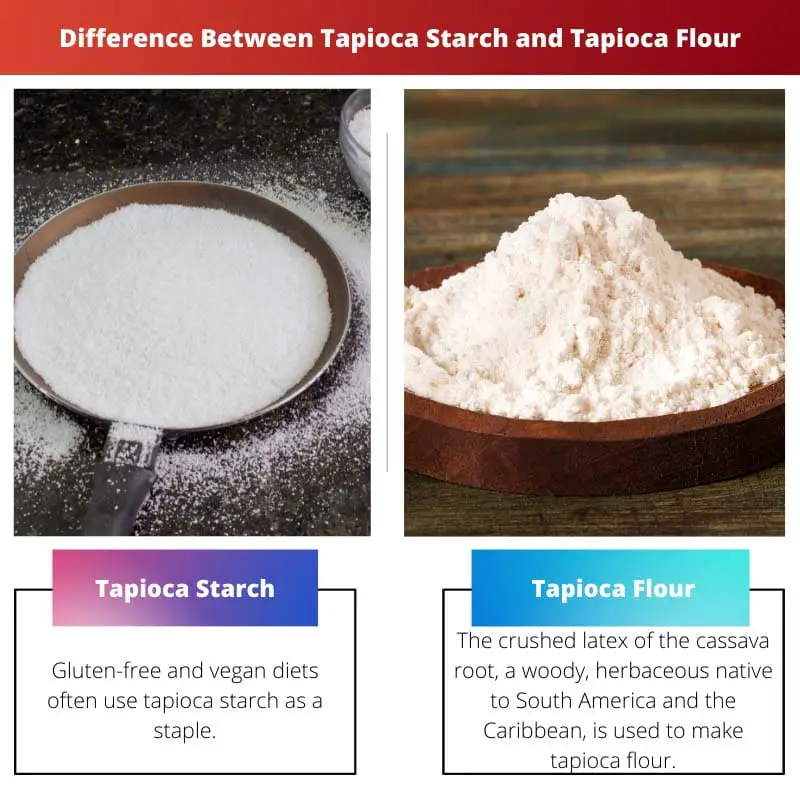In particular, there isn’t much of a gap since starch and flour seem similar. The label on the package varies widely depending on the manufacturer.
In the United States, the item is referred to as ‘tapioca flour,’ whereas Asian manufacturers refer to their products as ‘tapioca starch.’ In addition, the word to use in guidebooks and recipes is completely up to the author.
Key Takeaways
- Tapioca starch and tapioca flour are essentially the same things, the only difference being the name.
- Both are made from the cassava plant and are used as thickeners in cooking and baking.
- Tapioca starch/flour is gluten-free and can be used as a substitute for wheat flour in many recipes.
Tapioca Starch vs Tapioca Flour
Tapioca starch is obtained from the starch of cassava plants. The usage of tapioca starch depends on the recipe. It is difficult to balance the amount of tapioca starch in a recipe. Tapioca flour is obtained from the base of cassava plants. Tapioca flour is used to add flavour to the final dish. Some people use tapioca flour in place of tapioca starch.

Tapioca Starch is a form of staple that’s commonly found in gluten-free and vegan diets. They’re mainly encountered in Asian cuisine! For unknown reasons, Tapioca starch is preferred in Regional dishes over other types of starches such as cornflour, potato starch, and grain starch.
Tapioca flour is made from the cassava root’s crushed latex, a woody herbaceous common to South America and the Caribbean.
Even though both come out of the same plant, cassava flour and tapioca flour are not quite the same things. Cassava flour is made from the entire root, while tapioca flour is only extracted from the starchy paste.
Comparison Table
| Parameters of Comparison | Tapioca Starch | Tapioca Flour |
|---|---|---|
| Significance | Gluten-free and vegan diets use tapioca starch as a staple. | The crushed latex of the cassava root, a woody, herbaceous native to South America and the Caribbean, is used to make tapioca flour. |
| Produced from | The starch of a cassava plant is used to make Tapioca starch. | The base of the Cassava Plant is used to produce Tapioca Flour. |
| Labelling | Tapioca Starch and Flour are labeled the same in the United States. | In Asian Countries, both Tapioca Starch and Tapioca Flour are labeled differently. |
| Based On Recipes | It totally depends on the cookbook when it comes to using Tapioca Starch. | Tapioca Flour is also used in place of Starch in many cookbooks. |
| While Cooking | Most recipes call for some tapioca starch, but not very much, and striking the right balance can be difficult. | Tapioca flour can make meals slimy as well as impart a strong flavor to the finished product. |
What is Tapioca Starch?
It’s a starch that’s mostly used in gluten-free and vegetarian diets. They’re also commonly used in Asian food! Asian cuisines, for some reason, favour tapioca starch over other forms of starches such as cornmeal, potato starch, and grain starch.
Tapioca starch is also used to make your delectable boba pearls. Tapioca starch is derived from the cassava root after it has been processed and finely ground.
Tapioca is an English word from Latin American Tupi culture and relates to the method of making cassava edible. The root of the sour cassava plant is thought to be high in cooling glycosides, linamarin, and lotaustralin.
Tapioca is well-known for being gluten-free all over the world. Since nearly one in every 100 people in the United Kingdom suffers from gluten sensitivity, it benefits a wide range of people. Celiac syndrome is the medical name for gluten sensitivity.
Celiac disease is a disorder in which the small intestine’s lining is compromised, preventing it from receiving essential nutrients from food. It is seen that Gluten is seen in breadstuff, rye, grain, and oats.
The gastrointestinal region is in jeopardy as a consequence of the gluten reaction. As a result, those suffering from this disease prefer to consume pre-filtered tapioca flour for a variety of gastronomic purposes.

What is Tapioca Flour?
Tapioca flour is produced from the smashed sap of the cassava root, a woody, herbaceous native to South America and the Caribbean. Cassava flour and tapioca flour are not the same, even though they come from the same farm.
Cassava flour is made from the whole root, whereas tapioca flour is made only from the starchy paste. Like all refined carbs, Tapioca flour is a fine, white powder that works well in gluten-free cooking.
It can be used in place of cornstarch to thicken pies, terrines, pasta, bread, and sauce, and it helps in the creation of a crispy top and glossy surface in baking. It is most commonly used in the Brazilian delicacy Po de Queijo (shown below), a light, puffy cheese roll.
Cassava root is sliced, washed, and minced. The grinned sheepish pulp is then cleaned, pounded, and washed again until the mix is essentially pure starch and water. The starch is then dried after that.
We are aware of the dangers of unprocessed cassava root, and the product has been formulated acceptably to render it harmless.

Main Differences Between Tapioca Starch and Tapioca Flour
- Gluten-free and vegan diets use tapioca starch as a staple. Tapioca flour is made from the crushed latex of the cassava root, a woody, herbaceous native to South America and the Caribbean.
- Tapioca starch is made from the starch of a cassava plant, whereas the base of the Cassava Plant is used to produce Tapioca Flour.
- Tapioca Starch and Flour are labelled the same in the United States. On the other hand, In Asian Countries, both Tapioca Starch and Tapioca Flour are labelled differently.
- It totally depends on the cookbook when it comes to using Tapioca Starch. In several cookbooks, tapioca flour is substituted for starch.
- Most recipes call for a small amount of tapioca starch, and finding the right balance can be difficult. Tapioca flour can make foods slimy and add a strong flavour to the final product.

- https://d1wqtxts1xzle7.cloudfront.net/9382220/05-%20ifrj-2008-135%20nurul%20malaysia%202nd%20proof.pdf?1329529710=&response-content-disposition=inline%3B+filename%3DThe_effect_of_different_ratios_of_Dory_f.pdf&Expires=1621885110&Signature=W-c-FRi81fuxFSpF30HFlOljhQAdhQERF8zt1V7N~hRHKr2GXw9s8Wym7CYNaF~0v46YCldMvYy6psvhzbwJ-JrsHZ-W9gFTJ2s069Q-0GG-ypga7h38afLWoZwxW8QEv3-CpH3rIdPHSO7u4v6MKSLOQ5759NJNirL8yVSzLWFcTTK1bZw31y0FApcn3blQUrsXrSEPaeyCctsijIKTnhKBQh537W6wKiCVqSS14SibIbU8Iwm3N8jotI3WdSj-Ns4FC36NDE-F2r8RtUwr20JZD1xvatakvfPwhbUppQ0tFUzDviKjc8bvB~cPg5s8j7oCzXA2CJpmachnBSN-1g__&Key-Pair-Id=APKAJLOHF5GGSLRBV4ZA
- https://link.springer.com/article/10.1007/s13196-018-0226-1

The comparison table provided is very helpful in understanding the differences between tapioca starch and flour. It’s important to have this clarity, especially for those who use these in their cooking.
Absolutely, having this differentiation is crucial for those with specific dietary needs.
Agreed. Most people have been using these terms interchangeably without knowing the nuances between them.
The article does a great job of highlighting the differences between tapioca starch and flour, especially in terms of their uses and effects in cooking. The insights provided here are valuable.
Absolutely, understanding the applications and impacts of these ingredients is crucial for anyone who enjoys cooking.
The comparison between tapioca starch and flour in terms of recipes and cooking methods is quite enlightening. Understanding the effects of each in cooking helps in making informed decisions.
Absolutely, knowing how each ingredient behaves in cooking can greatly impact the final dish.
I couldn’t agree more. It’s all about understanding the characteristics and suitability of each ingredient.
The explanation about the manufacturing, labelling, and uses of both tapioca starch and flour is very informative. This article has cleared up the confusion for me.
I second that. Understanding the sources and applications of these products is key to utilizing them effectively in cooking.
The article’s explanation of tapioca flour and its origins, especially in relation to cassava flour, provides a clear understanding of these ingredients. This kind of detailed discussion is very valuable.
I completely agree. Such detailed discussions about ingredients are necessary for making conscious decisions.
Absolutely, it’s always great to have clear insights into the ingredients we use in our cooking.
The article provides detailed information about the sources, usage, and labelling of tapioca starch and flour. This kind of in-depth discussion is necessary for a well-informed choice of ingredients.
I completely agree. This kind of knowledge empowers people to make healthier and suitable choices for their diets.
Absolutely, this is vital information, especially for those who suffer from gluten sensitivity or celiac disease.
The detailed explanation of tapioca starch and flour, including their relevance in gluten-free and vegan diets, is very helpful. This article has brought clarity to something that seemed confusing before.
Absolutely. The information presented here is crucial for those with dietary restrictions.
Understanding the origins and uses of these products is quite enlightening. The comparison table provides a comprehensive view of the differences between tapioca starch and flour.
Agreed. The details provided here are very valuable for those who are conscious of what they consume.
Absolutely, having this level of detail and clarity about these ingredients is essential for informed decision-making.
The difference in names of tapioca flour and starch and the variations are quite interesting as it is something that is not spoken about. This explains why many people might not even be aware of the differences between the two.
Absolutely, and the fact that both are gluten-free alternatives makes them important for people with dietary restrictions.
The information about tapioca starch and flour’s gluten-free nature and their significance in gluten sensitivity is very insightful. This kind of knowledge is important for many people.
Agreed. This kind of information benefits people wanting to make informed dietary choices.
Absolutely, especially in today’s health-conscious environment, being aware of such details is crucial.